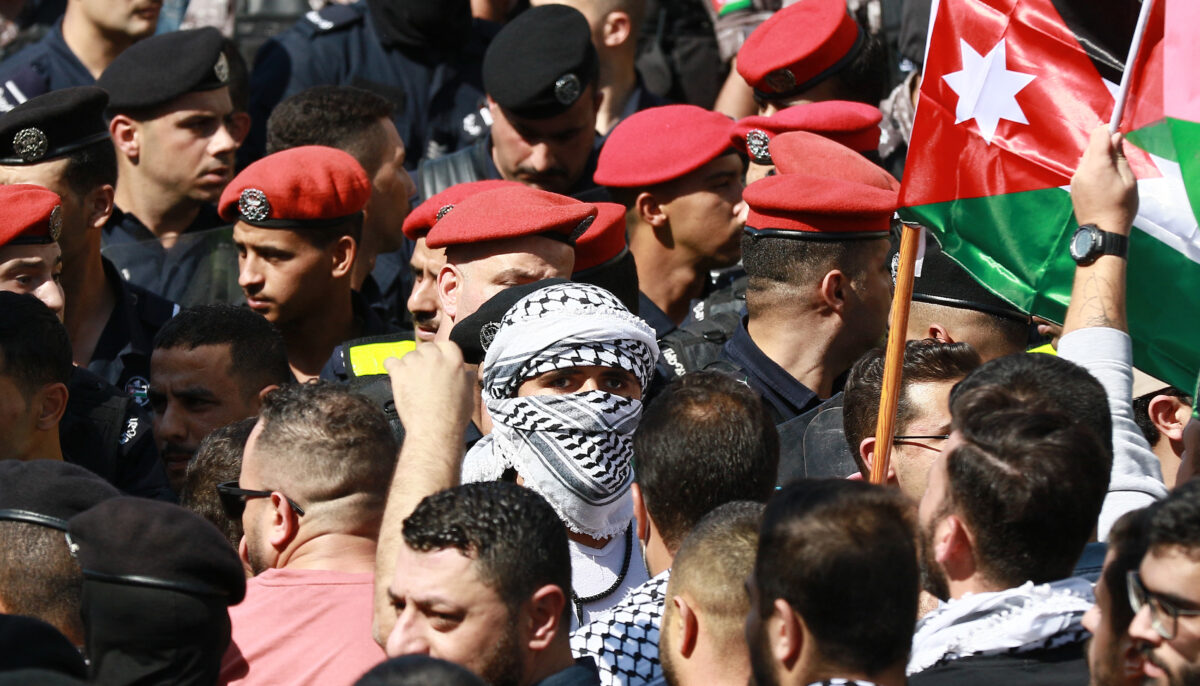In the days following October 8, Jordanians mobilized in solidarity with the people of Gaza, who, to this day, are still enduring nonstop Israeli bombardment. Demonstrations surged across Jordan, where protesters passionately called for a ceasefire and the revocation of agreements between Jordan and the Israeli occupation. However, their efforts were marred by obstacles and complications, hindering effective organization and communication.
Palestinians in the West Bank, as well as Jordanians, encountered a siege coinciding with the unfolding events in Gaza. In Jordan, citizens who participated in movements expressing solidarity with Gazans and condemning the occupation were stopped and searched. Additionally, demonstrators reported substantial interference with the internet and all communications. Conversing with SMEX, they chose to withhold their identities to safeguard their security.
Bayan Abu Tamiya, a young Jordanian participant in the demonstrations, told SMEX that since October 8, the internet’s functionality has progressively diminished, particularly during the days of sit-ins. She highlighted that it now takes up to an hour to post a tweet, and at times, the connectivity is completely severed. This communication breakdown significantly hindered demonstrators from coordinating their movements and checking on each other.
Furthermore, Abu Tamiya informed SMEX that the disruption of the communications network paralleled the disruption of internet services. She emphasized that interference intensifies during days marked by unrest, violence, and clashes between demonstrators and security personnel.
Reem (opting for a pseudonym to safeguard her safety) echoes Abu Tamiya’s concerns regarding internet interference during sit-ins. She shared her experience with SMEX, emphasizing the challenges in accessing the internet near demonstration sites. Sending pictures or uploading videos to social networking sites or even accessing “Telegram” channels becomes nearly impossible. After encountering considerable difficulties and persistent efforts, she finally established a connection, albeit at a 3G speed.
In contrast, the situation in the West Bank diverges from that in Jordan. Jalal Abukhater, Advocacy Manager at “7amleh,” a non-profit civil society organization advocating for Palestinian digital rights, detailed in an interview with SMEX that demonstrators faced a blatant violation of privacy. Occupation forces intruded into their digital spaces, forcefully confiscating phones and compelling individuals to disclose passwords for their social networking accounts.
In the West Bank, a series of violations were documented, ranging from harassment and defamation on social media to security summons, arrests, physical harm, and even dismissals from work. Meanwhile, in the Gaza Strip, the Israeli occupation army repeatedly severed all forms of communication and internet access, a blatant violation of fundamental human rights. Abukhater, speaking to SMEX, highlighted the gravity of these incidents.
In Jordan, while interference disrupting communications was evident, tracking and monitoring proved challenging. Issa Mahasneh, a technical expert, explained to SMEX that confirming network interference is difficult unless examined during demonstrations.
Mahasneh outlined factors influencing interference monitoring, including the ratio of demonstrators to the number of nearby communication towers. Small gatherings, such as those comprising 100 people, may not strain the network, but the presence of thousands in one area can indeed impact its functionality.
Mahasneh highlighted the existence of devices specifically designed for jamming communication networks and the internet. These devices are widespread and employed globally. However, he emphasized the difficulty in confirming whether they were actually used during the demonstrations in support of Gaza in Palestine and Jordan. Importantly, the interference affects all users of telecommunication networks equally, regardless of their affiliation with networks such as “Orange” or “Zain.”
Mahasneh stressed that without technical evidence, no party can conclusively prove interference during the demonstrations. He clarified that fluctuations in network connection intensity from one day to the next do not constitute evidence of network pressure.
Since October 9, Gaza’s 2.3 million residents have endured a profound and nearly absolute communications blackout, intensifying their hardship amid relentless Israeli bombardment and siege, preventing them from locating and accessing essentials like water, food, fuel, and medicine.
Gazans’ inability to secure continuous internet access and communication tools deepens their fear and uncertainty. They are unable to check on their loved ones, communicate, access critical information, or document the egregious human rights violations and atrocities occurring on their land.
On January 17, for the ninth time since October 8, 2023, communications and internet services were severed due to the ongoing Israeli bombing. The government media office in Gaza labeled the recurrent shutdowns as “complete, premeditated crimes,” underscoring their role in worsening the already dire humanitarian crisis in the Strip. The two Palestinian telecommunications companies operating in Gaza confirmed last Friday that a service outage affected most parts of Gaza.
Throughout October 2023, internet traffic in Gaza plummeted by over 80%, a consequence of direct attacks on civilian communication infrastructure, restrictions on electricity access, and technical failures in communication services.



